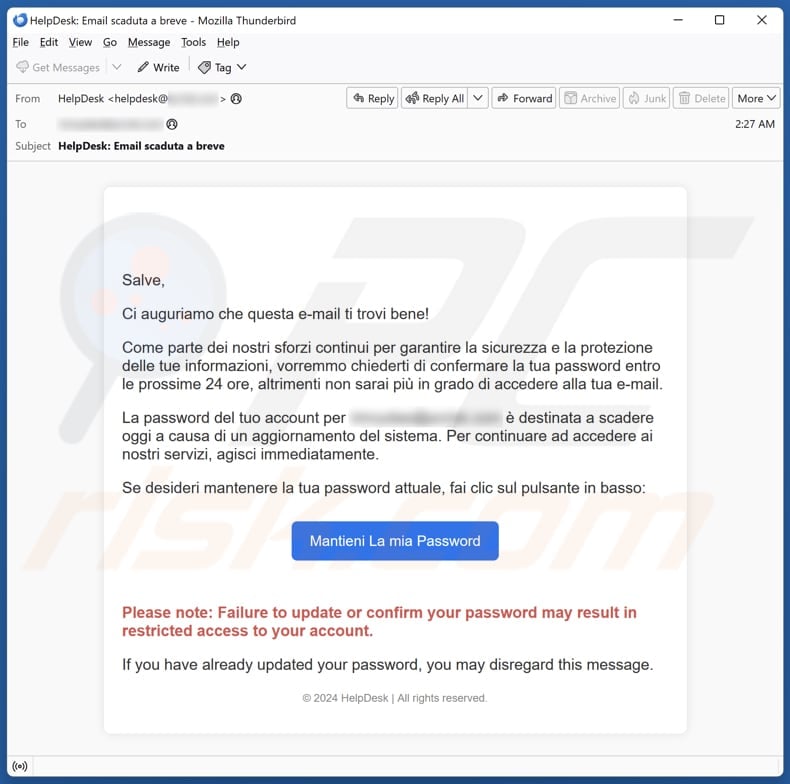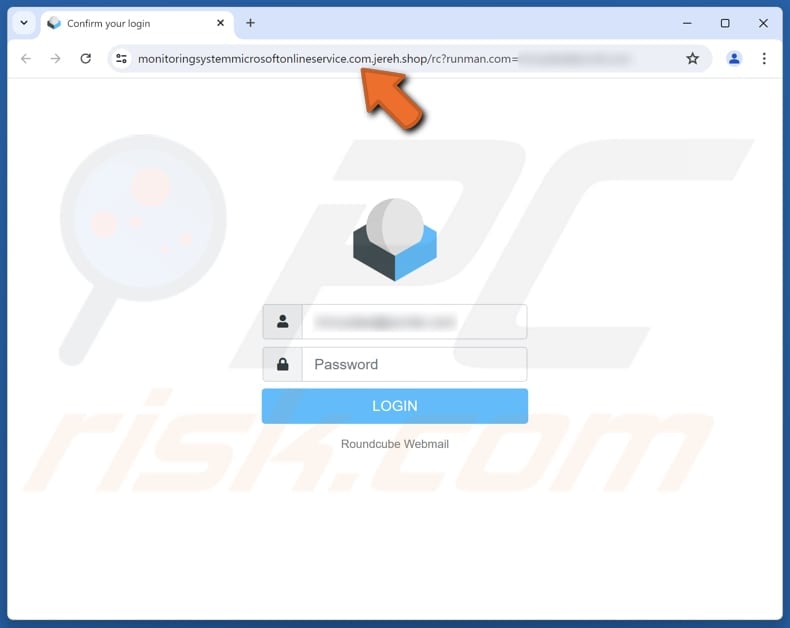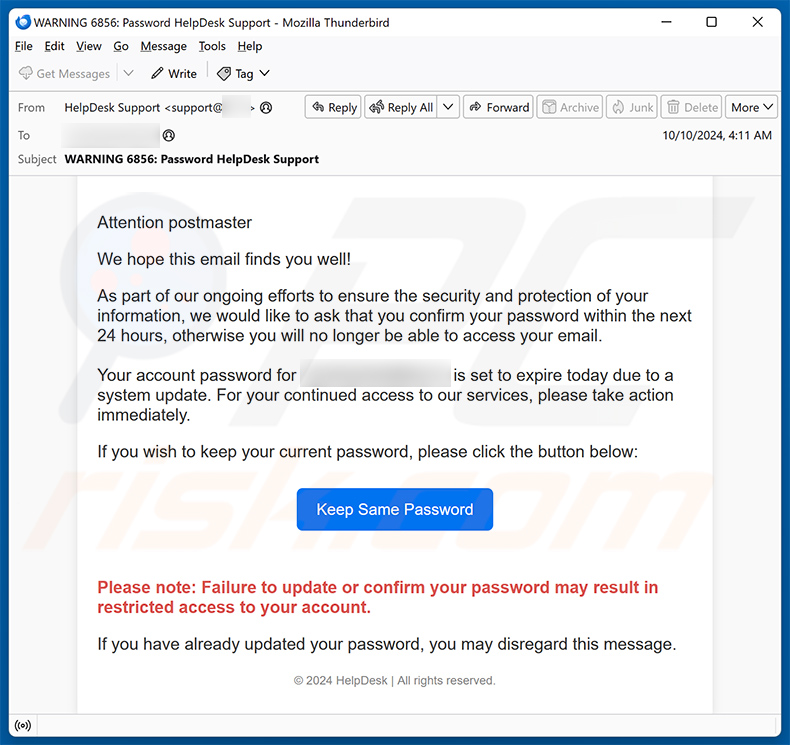How to recognize phishing attempts like "HelpDesk Password Confirmation"
Phishing/ScamAlso Known As: HelpDesk Password Confirmation phishing email
Get free scan and check if your device is infected.
Remove it nowTo use full-featured product, you have to purchase a license for Combo Cleaner. Seven days free trial available. Combo Cleaner is owned and operated by RCS LT, the parent company of PCRisk.com.
What is "HelpDesk Password Confirmation"?
While inspecting the email, we found it to be a phishing attempt. The scammers who crafted this email pretend to be the HelpDesk support team. Their goal is to trick recipients into believing they must confirm their email account password via the provided web page. Whoever receives this or a similar email should ignore it.

More about the "HelpDesk Password Confirmation" scam email
This email is written in Italian. It says that as part of ongoing efforts to ensure the safety and security of user information, HelpDesk requires the recipient to confirm their email account password within 24 hours. If not, they will no longer be able to access their email. It claims that the recipient's account will expire due to a system update, and immediate action is required.
Furthermore, this email instructs the recipient to click the "Keep My Password" button/link if they wish to keep their current password. Clicking the provided link opens a fake login form requesting to provide an email address and password (login credentials). The information entered on this page is sent to scammers.
Once scammers have stolen email account login credentials, they can access the account and send scam emails to contacts, look for personal information within the victim's emails, try to reset passwords for the accounts linked to the email account, and perform other malicious activities. They may also try to access other accounts (e.g., social media, gaming, banking) using the stolen credentials.
Additionally, scammers might sell login credentials (and other information obtained through accessed accounts) to other cybercriminals. Thus, it is important to be cautious when encountering requests to provide personal information to avoid falling victim to scams.
| Name | HelpDesk Password Confirmation Email Scam |
| Threat Type | Phishing, Scam, Social Engineering, Fraud |
| Fake Claim | The recipients email account will expire in 24 hours |
| Related Domain | monitoringsystemmicrosoftonlineservice.com.jereh[.]shop |
| Detection Names | Combo Cleaner (Phishing), CyRadar (Phishing), Fortinet (Spam), G-Data (Phishing), Trustwave (Suspicious), Full List Of Detections (VirusTotal) |
| Disguise | Notification from HelpDesk |
| Symptoms | Unauthorized online purchases, changed online account passwords, identity theft, illegal access of the computer. |
| Distribution methods | Deceptive emails, rogue online pop-up ads, search engine poisoning techniques, misspelled domains. |
| Damage | Loss of sensitive private information, monetary loss, identity theft. |
| Malware Removal (Windows) |
To eliminate possible malware infections, scan your computer with legitimate antivirus software. Our security researchers recommend using Combo Cleaner. Download Combo CleanerTo use full-featured product, you have to purchase a license for Combo Cleaner. 7 days free trial available. Combo Cleaner is owned and operated by RCS LT, the parent company of PCRisk.com. |
Similar scam emails in general
Phishing emails are designed to look like legitimate letters from trusted companies or organizations. These deceptive messages typically urge recipients to share personal details by replying directly, through attached files, or included websites. Once cybercriminals capture the targeted information, they can use it for malicious activities.
Examples of similar scam emails are "Bank Transfer Accounting Copy", "You Have Crucial Mails Pending", and "Internet Corporation For Assigned Names And Numbers (ICANN)". Such emails can also be used to trick recipients into infecting their computers.
How do spam campaigns infect computers?
Cybercriminals often use email to trick users into downloading and opening malicious files or clicking harmful links. These files can come in formats like executables, Microsoft Office documents, ISO images, compressed files (like ZIP), PDFs, and script files. Once users open them (or take additional steps), these files can deploy malware on the victim's device.
Links in such emails may lead to deceptive websites designed to trick users into downloading malware, or they may automatically trigger the download of harmful files or programs.
How to avoid installation of malware?
Examine emails before clicking links or opening attachments, especially if they appear irrelevant, unexpected, and (or) are from unknown addresses. Always download files or software directly from official websites or trusted app stores. Avoid clicking on ads, buttons, or links on questionable web pages.
Regularly update your operating system and software to ensure they have the latest security patches. Use a trusted security program and perform regular system scans. If you have already opened malicious attachments, we recommend running a scan with Combo Cleaner Antivirus for Windows to automatically eliminate infiltrated malware.
Text presented in the "HelpDesk Password Confirmation" email letter (in Italian):
Subject: HelpDesk: Email scaduta a breve
Salve,
Ci auguriamo che questa e-mail ti trovi bene!
Come parte dei nostri sforzi continui per garantire la sicurezza e la protezione delle tue informazioni, vorremmo chiederti di confermare la tua password entro le prossime 24 ore, altrimenti non sarai più in grado di accedere alla tua e-mail.
La password del tuo account per ******* è destinata a scadere oggi a causa di un aggiornamento del sistema. Per continuare ad accedere ai nostri servizi, agisci immediatamente.
Se desideri mantenere la tua password attuale, fai clic sul pulsante in basso:
Mantieni La mia Password
Please note: Failure to update or confirm your password may result in restricted access to your account.
If you have already updated your password, you may disregard this message.
© 2024 HelpDesk | All rights reserved.
Phishing website used in this scam:

An English variant of "HelpDesk Password Confirmation" scam email:

Text presented within:
Subject: WARNING 6856: Password HelpDesk Support
Attention postmaster
We hope this email finds you well!
As part of our ongoing efforts to ensure the security and protection of your information, we would like to ask that you confirm your password within the next 24 hours, otherwise you will no longer be able to access your email.
Your account password for ******** is set to expire today due to a system update. For your continued access to our services, please take action immediately.
If you wish to keep your current password, please click the button below:
Keep Same Password
Please note: Failure to update or confirm your password may result in restricted access to your account.
If you have already updated your password, you may disregard this message.
© 2024 HelpDesk | All rights reserved.
Instant automatic malware removal:
Manual threat removal might be a lengthy and complicated process that requires advanced IT skills. Combo Cleaner is a professional automatic malware removal tool that is recommended to get rid of malware. Download it by clicking the button below:
DOWNLOAD Combo CleanerBy downloading any software listed on this website you agree to our Privacy Policy and Terms of Use. To use full-featured product, you have to purchase a license for Combo Cleaner. 7 days free trial available. Combo Cleaner is owned and operated by RCS LT, the parent company of PCRisk.com.
Quick menu:
- What is HelpDesk Password Confirmation phishing email?
- Types of malicious emails.
- How to spot a malicious email?
- What to do if you fell for an email scam?
Types of malicious emails:
![]() Phishing Emails
Phishing Emails
Most commonly, cybercriminals use deceptive emails to trick Internet users into giving away their sensitive private information, for example, login information for various online services, email accounts, or online banking information.
Such attacks are called phishing. In a phishing attack, cybercriminals usually send an email message with some popular service logo (for example, Microsoft, DHL, Amazon, Netflix), create urgency (wrong shipping address, expired password, etc.), and place a link which they hope their potential victims will click on.
After clicking the link presented in such email message, victims are redirected to a fake website that looks identical or extremely similar to the original one. Victims are then asked to enter their password, credit card details, or some other information that gets stolen by cybercriminals.
![]() Emails with Malicious Attachments
Emails with Malicious Attachments
Another popular attack vector is email spam with malicious attachments that infect users' computers with malware. Malicious attachments usually carry trojans that are capable of stealing passwords, banking information, and other sensitive information.
In such attacks, cybercriminals' main goal is to trick their potential victims into opening an infected email attachment. To achieve this goal, email messages usually talk about recently received invoices, faxes, or voice messages.
If a potential victim falls for the lure and opens the attachment, their computers get infected, and cybercriminals can collect a lot of sensitive information.
While it's a more complicated method to steal personal information (spam filters and antivirus programs usually detect such attempts), if successful, cybercriminals can get a much wider array of data and can collect information for a long period of time.
![]() Sextortion Emails
Sextortion Emails
This is a type of phishing. In this case, users receive an email claiming that a cybercriminal could access the webcam of the potential victim and has a video recording of one's masturbation.
To get rid of the video, victims are asked to pay a ransom (usually using Bitcoin or another cryptocurrency). Nevertheless, all of these claims are false - users who receive such emails should ignore and delete them.
How to spot a malicious email?
While cyber criminals try to make their lure emails look trustworthy, here are some things that you should look for when trying to spot a phishing email:
- Check the sender's ("from") email address: Hover your mouse over the "from" address and check if it's legitimate. For example, if you received an email from Microsoft, be sure to check if the email address is @microsoft.com and not something suspicious like @m1crosoft.com, @microsfot.com, @account-security-noreply.com, etc.
- Check for generic greetings: If the greeting in the email is "Dear user", "Dear @youremail.com", "Dear valued customer", this should raise suspiciousness. Most commonly, companies call you by your name. Lack of this information could signal a phishing attempt.
- Check the links in the email: Hover your mouse over the link presented in the email, if the link that appears seems suspicious, don't click it. For example, if you received an email from Microsoft and the link in the email shows that it will go to firebasestorage.googleapis.com/v0... you shouldn't trust it. It's best not to click any links in the emails but to visit the company website that sent you the email in the first place.
- Don't blindly trust email attachments: Most commonly, legitimate companies will ask you to log in to their website and to view any documents there; if you received an email with an attachment, it's a good idea to scan it with an antivirus application. Infected email attachments are a common attack vector used by cybercriminals.
To minimise the risk of opening phishing and malicious emails we recommend using Combo Cleaner Antivirus for Windows.
Example of a spam email:

What to do if you fell for an email scam?
- If you clicked on a link in a phishing email and entered your password - be sure to change your password as soon as possible. Usually, cybercriminals collect stolen credentials and then sell them to other groups that use them for malicious purposes. If you change your password in a timely manner, there's a chance that criminals won't have enough time to do any damage.
- If you entered your credit card information - contact your bank as soon as possible and explain the situation. There's a good chance that you will need to cancel your compromised credit card and get a new one.
- If you see any signs of identity theft - you should immediately contact the Federal Trade Commission. This institution will collect information about your situation and create a personal recovery plan.
- If you opened a malicious attachment - your computer is probably infected, you should scan it with a reputable antivirus application. For this purpose, we recommend using Combo Cleaner Antivirus for Windows.
- Help other Internet users - report phishing emails to Anti-Phishing Working Group, FBI’s Internet Crime Complaint Center, National Fraud Information Center and U.S. Department of Justice.
Frequently Asked Questions (FAQ)
Why did I receive this email?
You likely received this email because scammers, who usually send mass phishing emails, obtained your email address and randomly targeted you.
I have provided my personal information when tricked by this email, what should I do?
If scammers stole your email account login credentials, immediately change your password and enable two-factor authentication (if possible). Also, monitor other accounts that may share similar credentials.
I have downloaded and opened a malicious file attached to an email, is my computer infected?
It depends on the type of file. For example, if you opened an infected Word document but did not enable macros, you probably avoided malware infiltration. However, if you opened a malicious executable, it likely infected the system.
I have read the email but did not open the attachment, is my computer infected?
Simply opening an email is harmless. Infections can occur when you click malicious links or open attached files found in fraudulent emails.
Will Combo Cleaner remove malware infections that were present in email attachment?
Yes, Combo Cleaner can find and remove nearly all known malware infections. However, advanced malware often conceals itself deep within the system, so it is essential to perform a full system scan.
Share:

Tomas Meskauskas
Expert security researcher, professional malware analyst
I am passionate about computer security and technology. I have an experience of over 10 years working in various companies related to computer technical issue solving and Internet security. I have been working as an author and editor for pcrisk.com since 2010. Follow me on Twitter and LinkedIn to stay informed about the latest online security threats.
PCrisk security portal is brought by a company RCS LT.
Joined forces of security researchers help educate computer users about the latest online security threats. More information about the company RCS LT.
Our malware removal guides are free. However, if you want to support us you can send us a donation.
DonatePCrisk security portal is brought by a company RCS LT.
Joined forces of security researchers help educate computer users about the latest online security threats. More information about the company RCS LT.
Our malware removal guides are free. However, if you want to support us you can send us a donation.
Donate
▼ Show Discussion